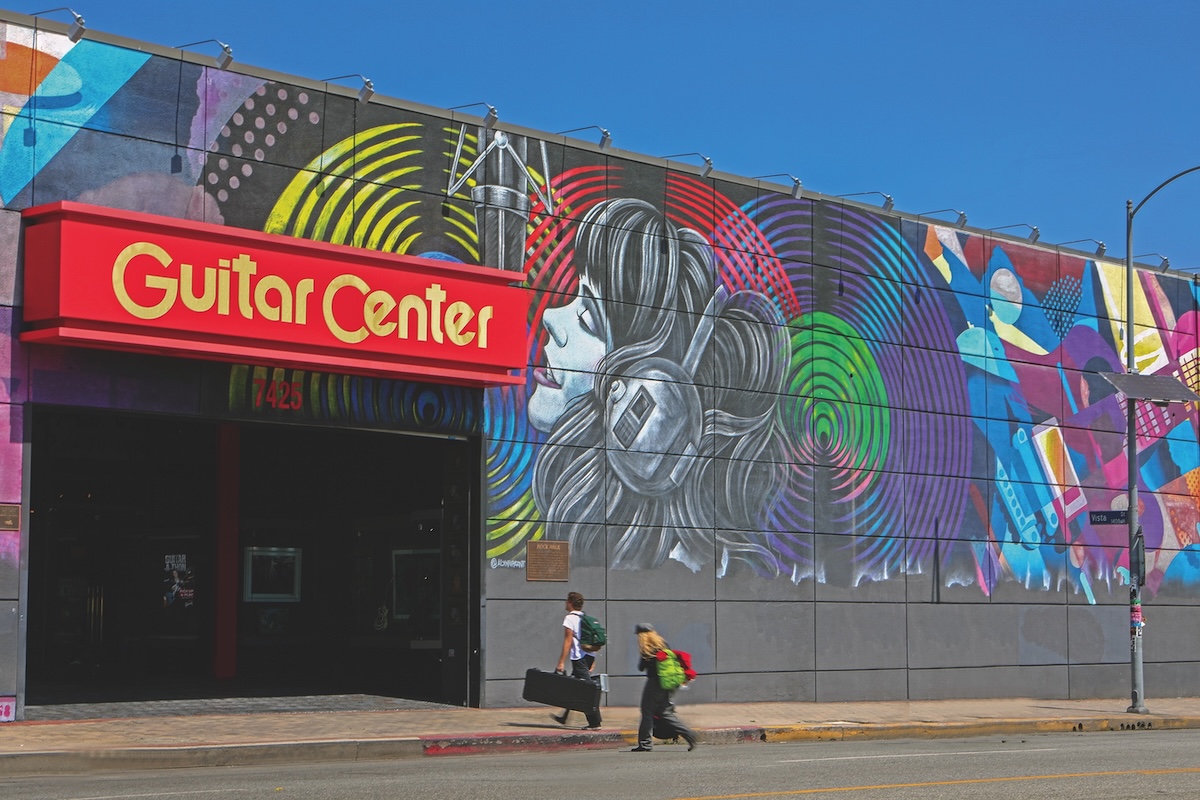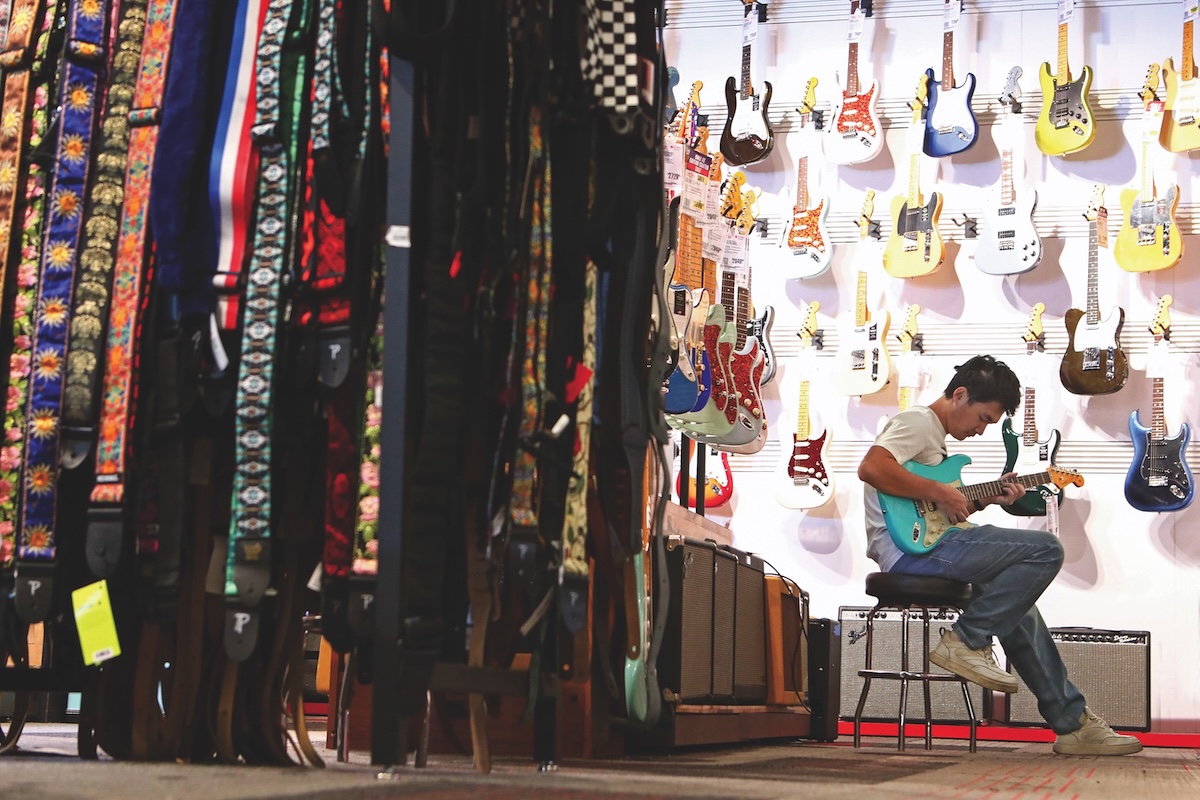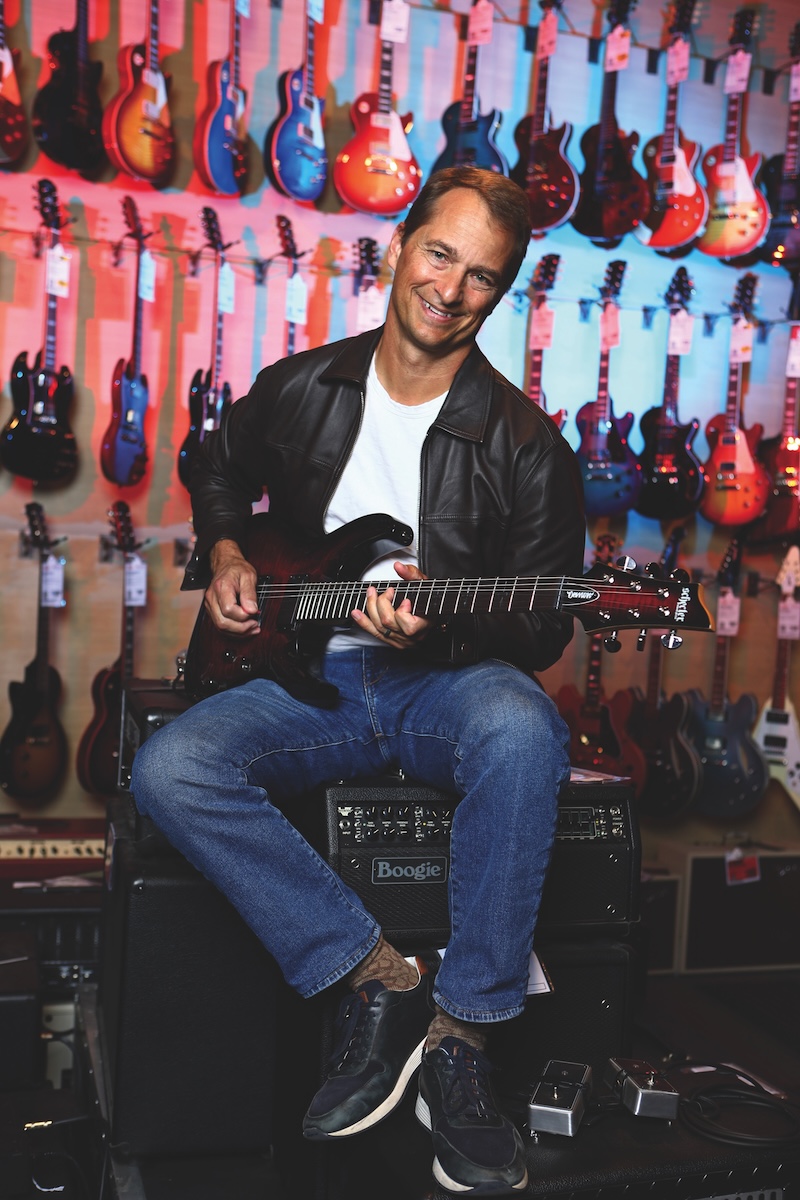Gabe Dalporto, the chief executive of Guitar Center Inc., is on a mission to get the Westlake Village-based music retailer back in harmony with its main customer base – the true musicians.
Before taking the top job, the struggling retailer had faced significant challenges following the e-commerce boom, especially in music retail. By the end of 2020, it emerged from Chapter 11 bankruptcy, primarily due to disruptions caused by the Covid-19 pandemic. The company is still heavily leveraged with debt, which was due in January 2026. In July, it announced it had reached an agreement with an “ad hoc group of investors” to extent that repayment period by three years.
With more breathing room, the retailer now has the time to execute its business plan, which has included revamping the entire shopping experience for its customers. In July, Guitar Center unveiled a new AI shopping assistant directly on its store floors.
Guitar Center remains one of the few music retailers still standing. Last year, the New York-based chain Sam Ash closed its remaining stores. Market research from IBISWorld shows that music retailers who expanded online have been better able to weather the storm. Guitar Center is among the stronger players, with IBIS estimating it controls 34% of the music retail market.
In an interview with the Business Journal, Dalporto shared his optimism and outlook for Guitar Center amid the economic and financial challenges, as well as the shifting landscape of the music industry.
You’ve built a successful career in tech. What prompted you to join the Guitar Center board in 2018 and then take the CEO role in 2023?
I’ve been a lifelong musician, including playing live music in a regional band. I remember fondly visiting and spending time in Guitar Centers with my father. It was a real wonderland for a kid who grew up in the mountains of West Virginia, unlike anything I’d ever seen before.
Professionally I built my career building and scaling digital businesses. These were innovative, fast-paced companies trying to shake up the world. And for decades, my personal and professional passions never intersected. When I met Guitar Center in 2018, they had this incredibly brick and mortar business that was getting walloped by digital competitors. So, they asked me to join and help mentor the management team on digital strategies. I was thrilled to help and enjoyed that experience immensely. I was surprised how much energy it gave me to combine my personal and professional passions.
When the CEO role opened in 2023, I wasn’t an obvious choice because I had no retail experience. But having spent five years on the board, along with spending countless hours in the stores as a customer, I had a pretty good sense of what the company needed to do to turn its fortunes around. So, I put together a comprehensive strategy and pitched it to the board. Thankfully they agreed with it and gave me the opportunity.
You’ve helped Guitar Center emerge out of bankruptcy. What do you consider to be some of your greatest challenges faced during that process, and why?
At that time (in late 2020), I was a board member and not part of management, so I wasn’t responsible for the operations or strategy of the business. My role was making sure the new ownership and capital structure post-bankruptcy were in the best interest of the company.
I took over as CEO on October 31, 2023, at which point my responsibilities expanded to include the strategy and operations of the company. There’s a great culture here, and everyone was dressed up for Halloween. It was a hoot meeting everyone in their costumes.
Where do you see the challenges for Guitar Center now, and for yourself as CEO, and dealing with the aftermath of the bankruptcy?
Frankly, the company was struggling when I took over as CEO. We were about to deliver our ninth consecutive quarter of negative growth. If I really boil it down to the simplest terms, the company had forgotten who its core customer was. Business is often pretty simple. Know your customer and serve your customers. Our customer is what we call the “serious musician.” That’s basically anyone for whom playing music is a big piece of their life and identity. Well, we’d basically stopped providing the products, services and experiences that mattered most to them.

What is Guitar Center doing to attract its existing customer base and new musicians to their stores and online platform, especially as the music culture continues to shift?
We’re leaning into emerging tech and trends to reinvent physical retail. We recently launched Rig Advisor in all 300 stores, which is an AI-powered tool for customers that’s like having the most knowledgeable gear tech in the history of the world standing beside you in store making recommendations. Want to sound in Jimmy Hendrix playing “Purple Haze?” Rig Advisor will tell you which guitar to grab, what pedals to plug into and what settings to dial in that exact tone. Need a PA system to play live gigs but only have $5,000? It will construct the best possible solution available right now in that store so you can start gigging tonight.
The company has closed its ‘low performing’ stores including its West L.A. location in January. Will there be more closures? And how does that fit into the broader strategy for the retailer?
No, virtually all our stores are performing well, and we don’t foresee meaningful store closures in the Guitar Center brand.
You’ve talked about taking a more ‘omnichannel’ approach in terms of expanding the company’s online presence. Can you outline what that strategy looks like?
Everything, everywhere, all at once. Here’s what I mean by that. Boring ecommerce is selling product from your website to a web customer. That’s so 2000s. More interesting is giving the customer a choice to have it shipped to their house or pick it up locally. What we’re doing goes much further. All 300 stores buy an enormous amount of used and vintage gear every day. We are by far the largest owner of used and vintage equipment in the world. Historically, this inventory just sat in the store. But now we photograph and list it on our website. So, anyone in the world can see and buy that sweet 1952 telecaster in the Portland store from anywhere else in the country. This is like nirvana for gear nerds.
For the current Guitar Center stores, what changes can customers expect to see when they walk into a Guitar Center now? Can you walk me through the specific changes you’ve made?
The only right a brick-and-mortar retail store has to exist is to deliver an extraordinary experience. Full stop. You can literally buy anything online without getting off your couch. When someone walks into Guitar Center, it better feel like you walked through the gates of an amusement park.
We are creating a deeply engaging environment in the stores. Everything is ready and accessible to be played. You can walk up to the guitar wall, grab a $3,000 axe, plug it into our one-of-a-kind pedal islands and explore 50 to 100 unique sounds and effects. Across the entire store, you’ll find the ability to play and also play.
How has Guitar Center made inroads in competing against larger players in e-commerce like Amazon.com Inc. and Sweetwater Sound? How has Guitar Center changed its e-commerce program?
I met the iconic Grammy award-winning writers and producers Jimmy Jam and Terry Lewis the other night. Terry was talking about his first time in a Guitar Center, and how he spent hours and hours sorting through over 100 guitars until he found the one that was the exact fit for him, and what a magical experience that was. That’s because you can take three identical guitars – the exact same model – and they all weigh a little different, feel a little different, sound a little different and have different wood grains that affect all the above plus aesthetics.
From what we can tell, for the first time in decades, we’re taking share from online competitors. And we’re doing it by making it fun to explore music and sound.

How has your customer base responded to the shifts in the shopping experience, including online and at your stores?
I’m humbled by the response. After over a decade of online competitors taking share from brick and mortar and 12 years of declining traffic, we’ve now seen six consecutive quarters of revenue growth and four consecutive quarters of traffic growth. And not only are more people coming through our doors – they’re spending 18% more time in store than they did two years ago. In short, they’re having a blast.
What is Guitar Center’s strongest category? What new sales categories show the most promise to be strong performers?
Guitars. They are our heritage, and they have been the cornerstone of music for the past 70 years. But what’s truly unique about Guitar Center stores is they are truly musical wonderlands. We cover the full spectrum of instruments, including tech categories like DJ, live sounds, studio sound, recording, keyboards, synthesizers and much more.
There’s been a shift in musical tastes. The pop music audience of the 1990s has different tastes than the pop music audience of the 2020s. How does that shift reflect in which instruments sell?
I was talking to Andy Mooney, CEO of Fender, a couple days ago. Neither of us subscribe to the idea that the guitar is going anywhere. It’s the cornerstone of modern music.
That said, music has been a constantly evolving art form since well before the days of Mozart. And if anything, it’s been accelerating since Robert Moog introduced the first modern synthesizer in the ’60s. Today’s Guitar Center is a musical wonderland filled with modern tools and workstations to create the most cutting-edge music you couldn’t imagine 10 years ago.
And probably the most incredible thing is the democratization of recording. Twenty years ago, it was still extremely expensive to record and produce an album. Now any customer with a couple grand can put together a credible recording studio and digital production environment to crank out a really high-quality production. No longer are there gatekeepers who can tell musicians “No. No, you can’t record your record. No, you can’t have access to millions of listeners.” Today’s musician can simply say “Yes” to themselves.
